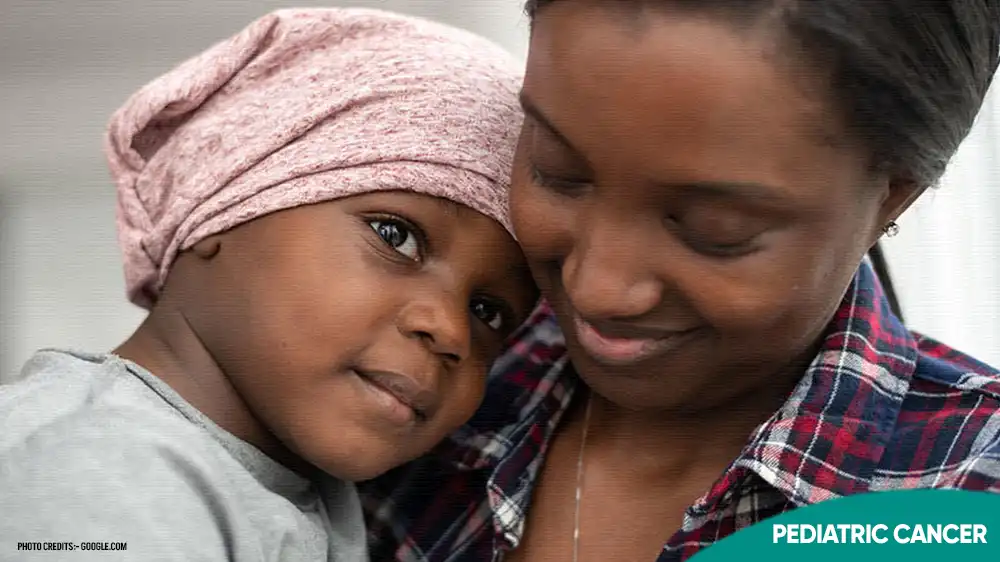
HEALTH BLOG
What is Pediatric Cancer? and Current 2024 Research
-
 Rahul Priydarss
Rahul Priydarss - June 8, 2024
Discover the comprehensive guide to pediatric cancer, covering types, symptoms, diagnosis, causes, and treatment options. Learn about the latest research advancements and how early detection and multidisciplinary care are crucial for improving outcomes. Explore the various treatment modalities, including surgery, chemotherapy, radiation therapy, targeted therapy, immunotherapy, and supportive care, aimed at enhancing survival rates and minimizing treatment-related side effects.
Introduction of Pediatric Cancer:
Pediatric cancer, often referred to as childhood cancer, is a term used to describe cancers that occur in children and adolescents. These cancers are distinct from adult cancers, not just in the types that commonly occur, but also in how they grow and respond to treatment. Understanding pediatric cancer is crucial for early diagnosis and effective treatment, ultimately improving survival rates and quality of life for young patients.
What is Pediatric Cancer:
Pediatric cancer refers to cancers that occur in children and adolescents. These cancers result from DNA changes early in life and can develop in various parts of the body, including the blood, brain, bones, and organs. Common types include leukemia, brain and central nervous system tumors, neuroblastoma, Wilms tumor, lymphoma, rhabdomyosarcoma, retinoblastoma, and bone cancers. Treatment often involves surgery, chemotherapy, radiation therapy, and sometimes stem cell transplants, with a focus on minimizing long-term side effects and ensuring healthy development.

Table of Contents
Types of Pediatric Cancer:
Pediatric cancer encompasses various types of cancers that affect children and adolescents. These cancers can arise in different parts of the body, and each type presents its unique challenges in terms of diagnosis, treatment, and prognosis.
Leukemia: Leukemia is the most common type of pediatric cancer, accounting for about one-third of all childhood cancer cases. It is a blood and bone marrow cancer, where abnormal white blood cells multiply uncontrollably. The two primary types of leukemia seen in children are acute lymphoblastic leukemia (ALL) and acute myeloid leukemia (AML). Treatment typically involves chemotherapy, targeted therapy, and sometimes stem cell transplantation.
Brain and Central Nervous System Tumors: Brain tumors are the second most common type of pediatric cancer. These tumors can develop in various parts of the brain and spinal cord and include types such as gliomas, medulloblastomas, ependymomas, and astrocytomas. Treatment may involve surgery, chemotherapy, radiation therapy, or a combination of these approaches, depending on the tumor type, location, and other factors.
Neuroblastoma: Neuroblastoma is a cancer that develops from immature nerve cells, most commonly found in the adrenal glands but can also occur in other areas of the abdomen, chest, neck, and pelvis. It typically affects infants and young children. Treatment for neuroblastoma often involves surgery, chemotherapy, radiation therapy, and sometimes stem cell transplantation.
Wilms Tumor: Wilms tumor, also known as nephroblastoma, is a type of kidney cancer that primarily affects children. It usually occurs in children around the age of 3 to 4 years old. Treatment typically involves surgery to remove the tumor, followed by chemotherapy and sometimes radiation therapy.
Lymphoma: Lymphoma is a cancer of the lymphatic system, which includes Hodgkin lymphoma and non-Hodgkin lymphoma. Both types can occur in children, with Hodgkin lymphoma being more common in adolescents. Treatment usually involves chemotherapy and sometimes radiation therapy, with a high rate of cure, especially for Hodgkin lymphoma.
Rhabdomyosarcoma: Rhabdomyosarcoma is a cancer that develops in the soft tissues, particularly in muscles. It is one of the most common soft tissue sarcomas in children. Treatment may include surgery, chemotherapy, and radiation therapy, depending on the size, location, and extent of the tumor.
Retinoblastoma: Retinoblastoma is a rare type of eye cancer that primarily affects young children, usually before the age of 5. It develops in the retina, the light-sensitive tissue at the back of the eye. Treatment often involves chemotherapy, radiation therapy, cryotherapy, laser therapy, or surgery, depending on the size and location of the tumor.
Bone Cancers: Bone cancers in children include osteosarcoma and Ewing sarcoma. Osteosarcoma is the most common type of bone cancer in children and adolescents, while Ewing sarcoma is less common but tends to occur in slightly older children and teenagers. Treatment usually involves a combination of surgery, chemotherapy, and sometimes radiation therapy.
Causes of Pediatric Cancer:
The exact causes of pediatric cancer are not fully understood, but they are believed to result from a combination of genetic, environmental, and lifestyle factors. Here are some factors that may contribute to the development of pediatric cancer.
Genetic Predisposition: Some children may inherit genetic mutations that increase their risk of developing cancer. These mutations can be passed down from parents or occur spontaneously. Certain genetic syndromes, such as Li-Fraumeni syndrome, neurofibromatosis, and retinoblastoma, are associated with an increased risk of specific types of pediatric cancer.
DNA Mutations: Cancer occurs when genetic mutations disrupt the normal regulation of cell growth and division. These mutations can occur spontaneously or be triggered by exposure to environmental factors such as radiation, chemicals, or viruses. In pediatric cancer, these mutations may occur early in life, even before birth.
Exposure to Carcinogens: Children may be exposed to carcinogenic substances in their environment, such as tobacco smoke, air pollution, pesticides, and certain chemicals. Prenatal exposure to carcinogens, either through maternal exposure or exposure in utero, may also increase the risk of pediatric cancer.
Radiation Exposure: Exposure to ionizing radiation, such as radiation therapy used to treat other medical conditions, can increase the risk of developing cancer, including leukemia and brain tumors. However, the risk from diagnostic imaging tests such as X-rays and CT scans is generally considered to be very low.
Viral Infections: Certain viruses have been linked to an increased risk of pediatric cancer. For example, the Epstein-Barr virus (EBV) is associated with an increased risk of Hodgkin lymphoma and nasopharyngeal carcinoma, while the human papillomavirus (HPV) is associated with an increased risk of cervical cancer and other cancers.
Immune System Deficiencies: Children with weakened immune systems, such as those with HIV/AIDS or undergoing immunosuppressive therapy, may have an increased risk of developing certain types of cancer, including lymphoma and Kaposi sarcoma.
Unknown Factors: In many cases, the exact cause of pediatric cancer remains unknown. Research is ongoing to better understand the complex interplay of genetic and environmental factors that contribute to the development of cancer in children.
Symptoms of Pediatric Cancer:
The symptoms of pediatric cancer can vary depending on the type of cancer and its location in the body. It’s important for parents and caregivers to be aware of potential warning signs and seek medical attention if they notice any unusual or persistent symptoms in a child. Here are some common symptoms of pediatric cancer.
Unexplained Weight Loss: Significant and unexplained weight loss, especially in the absence of dieting or other obvious reasons, can be a sign of various types of pediatric cancer, including leukemia and lymphoma.
Persistent Fever: A persistent or recurrent fever that is not associated with an infection or other obvious cause may indicate certain types of cancer, such as leukemia or lymphoma.
Fatigue: Persistent fatigue, weakness, or lethargy that does not improve with rest can be a symptom of pediatric cancer, particularly leukemia and brain tumors.
Pain: Persistent pain, especially in the bones or joints, headaches, or abdominal pain, may be a symptom of cancer. Bone pain can be a sign of bone cancers like osteosarcoma or Ewing sarcoma, while headaches may be associated with brain tumors.
Lumps or Swellings: Unexplained lumps or swellings, particularly in the neck, abdomen, groin, or underarms, may indicate the presence of a tumor or cancerous growth.
Changes in Vision: Changes in vision, such as double vision, loss of peripheral vision, or the appearance of white spots in the pupil, may be symptoms of eye cancer (retinoblastoma) or brain tumors.
Persistent Infections: Children with certain types of cancer, particularly leukemia, may experience frequent or persistent infections due to a weakened immune system.
Bruising or Bleeding: Excessive bruising, bleeding gums, or frequent nosebleeds may be signs of leukemia, a cancer of the blood and bone marrow.
Changes in Bowel or Bladder Habits: Changes in bowel habits, such as constipation or diarrhea, blood in the stool, or changes in urinary frequency or color, may be symptoms of certain abdominal cancers.
Difficulty Breathing: Persistent coughing, wheezing, or shortness of breath may be symptoms of lung cancer or tumors pressing on the airways.
Unexplained Paleness: Unexplained paleness of the skin or mucous membranes (inside the mouth or eyelids) may be a sign of anemia, which can be associated with leukemia or other types of cancer.
Unexplained Night Sweats: Night sweats that are unrelated to room temperature or physical activity may be a symptom of certain types of cancer, such as lymphoma.

Diagnosis of Pediatric Cancer:
Diagnosing pediatric cancer typically involves a series of steps aimed at identifying the type, location, and extent of the cancer. Here’s an overview of the diagnostic process.
Medical History and Physical Examination: The first step in diagnosing pediatric cancer involves a thorough medical history review and physical examination by a healthcare provider. The doctor will ask questions about the child’s symptoms, family medical history, and any relevant risk factors. They will also conduct a comprehensive physical examination to look for signs of cancer, such as lumps, swelling, or other abnormalities.
Laboratory Tests: Laboratory tests are often used to evaluate blood, urine, and other bodily fluids for signs of cancer or abnormalities. Common tests include:
- Complete Blood Count (CBC): This test measures the number and types of blood cells and can help identify abnormalities associated with leukemia and other blood cancers.
- Blood Chemistry Tests: These tests evaluate the levels of various substances in the blood, such as electrolytes, liver enzymes, and kidney function markers, which may be affected by certain types of cancer.
- Tumor Markers: Some cancers produce specific proteins or other substances that can be detected in the blood. Tumor marker tests, such as alpha-fetoprotein (AFP) and beta-human chorionic gonadotropin (beta-hCG), may be used to diagnose and monitor certain types of pediatric cancer, such as liver cancer (hepatoblastoma) or germ cell tumors.
Imaging Studies: Imaging tests are essential for identifying the location, size, and extent of tumors and assessing whether cancer has spread to other parts of the body. Common imaging studies include:
- X-rays: X-rays may be used to examine the bones and detect abnormalities, such as bone tumors or fractures.
- Ultrasound: Ultrasound uses sound waves to create images of internal organs and tissues. It is often used to evaluate abdominal and pelvic tumors.
- Computed Tomography (CT) Scan: CT scans use a series of X-ray images to create detailed cross-sectional images of the body. They are useful for detecting tumors in the brain, chest, abdomen, and pelvis.
- Magnetic Resonance Imaging (MRI): MRI uses powerful magnets and radio waves to create detailed images of the body’s soft tissues. It is particularly helpful for evaluating tumors in the brain, spinal cord, and soft tissues.
- Positron Emission Tomography (PET) Scan: PET scans use a radioactive tracer to detect metabolic activity in the body. They can help identify areas of cancer spread (metastasis) and assess the overall extent of the disease.
Biopsy: A biopsy is the definitive diagnostic test for cancer and involves the removal of a small sample of tissue or cells from the suspected tumor for examination under a microscope. Depending on the location of the tumor, different biopsy techniques may be used:
- Surgical Biopsy: A surgical procedure to remove a sample of tissue from the tumor. It may be performed under general anesthesia.
- Needle Biopsy: A less invasive procedure in which a thin needle is used to extract a sample of tissue or cells from the tumor. Types of needle biopsies include fine-needle aspiration (FNA) biopsy and core needle biopsy.
Bone Marrow Aspiration and Biopsy: In cases of suspected leukemia or lymphoma, a bone marrow aspiration and biopsy may be performed to evaluate the bone marrow for the presence of cancer cells. This involves the insertion of a needle into the bone marrow space to collect a sample of marrow fluid (aspiration) and a small core of bone marrow tissue (biopsy).
- Genetic Testing: Genetic testing may be performed to identify specific genetic mutations or chromosomal abnormalities associated with certain types of pediatric cancer. This information can help guide treatment decisions and provide valuable insights into the child’s risk of developing other cancers or passing the mutation to future generations.
Treatment Options for Pediatric Cancer:
Treatment for pediatric cancer typically involves a combination of therapies tailored to the type and stage of cancer, as well as the child’s age, overall health, and individual circumstances. The main treatment modalities for pediatric cancer include.
Surgery: Surgery is often used to remove the tumor and surrounding tissue. The goal of surgery is to completely remove the cancerous cells whenever possible. In some cases, the entire tumor may be removed during surgery. In other cases, surgery may be used to obtain a biopsy sample or to debulk the tumor, reducing its size before other treatments such as chemotherapy or radiation therapy.
Chemotherapy: Chemotherapy involves the use of powerful medications to destroy cancer cells or prevent them from growing and dividing. Chemotherapy is often used as a systemic treatment, meaning it can reach cancer cells throughout the body via the bloodstream. It may be administered orally, intravenously (IV), or directly into a specific body cavity (intrathecal chemotherapy for cancers involving the central nervous system). Chemotherapy is frequently used as the primary treatment for many types of pediatric cancer, and it may be given before or after surgery or radiation therapy, depending on the specific treatment plan.
Radiation Therapy: Radiation therapy uses high-energy X-rays or other forms of radiation to kill cancer cells or shrink tumors. It is often used in combination with surgery and/or chemotherapy to treat certain types of pediatric cancer. Radiation therapy may be delivered externally (external beam radiation) or internally (brachytherapy), depending on the location and size of the tumor. While effective, radiation therapy may also cause side effects, particularly in growing children, so careful planning and monitoring are essential.
Stem Cell Transplantation: Stem cell transplantation, also known as bone marrow transplantation or hematopoietic stem cell transplantation, may be used in certain cases to replace damaged or diseased bone marrow with healthy stem cells. This procedure allows higher doses of chemotherapy or radiation therapy to be given, as it replenishes the bone marrow’s ability to produce blood cells. Stem cell transplantation is often used in the treatment of leukemia, lymphoma, and other cancers affecting the blood or bone marrow.
Targeted Therapy: Targeted therapy is a type of cancer treatment that specifically targets cancer cells while minimizing damage to normal cells. Targeted therapy drugs work by interfering with specific molecules involved in cancer cell growth and survival. These drugs may be used alone or in combination with other treatments such as chemotherapy or radiation therapy. Targeted therapy is particularly effective in treating certain types of pediatric cancer, such as neuroblastoma and certain types of leukemia.
Immunotherapy: Immunotherapy is a type of cancer treatment that helps the body’s immune system fight cancer. Immunotherapy drugs work by boosting the immune response or by targeting specific proteins on cancer cells. This treatment approach has shown promise in the treatment of certain types of pediatric cancer, including some types of leukemia, lymphoma, and neuroblastoma.
Supportive Care: Supportive care plays a crucial role in the comprehensive management of pediatric cancer. It includes various supportive measures to manage symptoms, alleviate treatment side effects, and improve the child’s overall quality of life. Supportive care may include pain management, nutritional support, psychosocial support, physical therapy, occupational therapy, and other interventions tailored to the child’s needs.
2024 Research and Advances in Pediatric Cancer:
There’s encouraging progress in pediatric cancer research for 2024! Here’s a glimpse into some key areas.
CAR-T cell therapy: This immunotherapy shows promise for childhood cancers, but research is ongoing to make it safer and more effective. New CAR-T therapies are being developed to target different cancers, with some companies seeking regulatory approval.
Precision medicine: Tailoring treatments to a child’s specific genetic makeup of their cancer is an area of active research. This approach aims to improve effectiveness and reduce side effects.
Early detection and relapse prevention: Researchers are developing new tools to detect cancer earlier and identify children at high risk of relapse. This could lead to more timely treatment and improved long-term outcomes.
Reducing treatment side effects: Researchers are looking for ways to make current treatments less toxic and develop new therapies with fewer side effects. This is especially important for children, who are more vulnerable to the long-term effects of treatment.
FAQs about Pediatric Cancer:
A1: Leukemia, specifically Acute Lymphoblastic Leukemia (ALL), is the most common type of pediatric cancer.
A2: While many pediatric cancers cannot be prevented due to their genetic origins, reducing exposure to known environmental risks can help. This includes avoiding tobacco smoke and unnecessary radiation.
A3: Survival rates vary by cancer type, but overall, about 80% of children with cancer now survive five years or more, thanks to advancements in treatment.
A4: Pediatric cancer treatment is tailored to the unique needs of growing children, often involving different drug dosages, supportive care measures, and consideration of long-term developmental impacts.
A5: If parents notice any unusual symptoms or signs in their child, they should consult a pediatrician promptly. Early diagnosis and treatment are crucial for the best outcomes.

-Please remember, to always consult with healthcare professionals or Doctors for personalised advice related to medical conditions.
Conclusion:
In conclusion, understanding and addressing pediatric cancer require early detection, multidisciplinary care, and advanced treatment modalities. With ongoing research and therapeutic advancements, including surgery, chemotherapy, radiation therapy, targeted therapy, immunotherapy, and supportive care, there is promising progress toward improving survival rates and minimizing treatment-related side effects. Vigilance and prompt intervention remain crucial for enhancing outcomes and ensuring a better quality of life for young patients.




